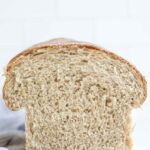Whole Wheat Sourdough Sandwich Bread
This delightful recipe combines the nutty, rich flavor of whole wheat with the naturally tangy bite of sourdough with a light airy crumb and chewy texture. Perfect for sandwiches, toast with jam, as a side, or just a snack
Servings: 10
Calories: 248kcal
Equipment
Ingredients
- 550 g fresh milled hard white wheat 4 cup + 2ish tablespoons
- 135 g active sourdough starter little less than 2/3 cup
- 370 g water a little over 1 3/4 cup
- 50 g olive oil about 1/4 cup
- 22 g sugar 2 tablespoons
- 10 g salt
Instructions
- Mill the hard white wheat berries into flour.
- Autolyse the dough by combining all of the ingredients in a bowl of a stand mixer or a large bowl. Mix until fully hydrated and there are no dry spots. Cover and let it sit for about 30 minutes to 1 hour.
- Knead the dough by hand or using a stand mixer for anywhere from 10-30 minutes until it becomes smooth and elastic. It should be able to stretch pretty thin without breaking. This dough is on the more hydrated side so you may need to grease or wet hands to work with the dough. If kneading by hand, you can use the “stretch and fold” technique. Stretch and fold the dough 30 minutes apart at least 3-6 times.
- Bulk Fermentation. Cover the bread dough with a damp towel or plastic wrap and let the dough rest in a warm place for 4-6 hours possibly up to 12 depending on how warm your house is. It should double in size.
- Shape the Dough. Once the dough has risen, gently turn it out onto an oiled surface. Shape it into a loaf by patting out into a rectangle, fold the edges into the middle, and then rolling up tightly. I like to also create tension by dragging the dough towards me.
- Place the shaped dough into a parchment lined or greased loaf pan. Let the dough rise for 1-2 hours or until about doubled. Or place in the fridge, covered with plastic for 15 hours.
- Preheat the oven to 375°F.
- Bake for 40-45 minutes or until an eternal temperature hits 190-210°F.
- Optional: for a more golden brown color, brush on an egg wash to the top of the dough.
- Remove the bread from the oven and let it cool on a wire rack for at least 30 minutes before slicing. Cutting into the bread while it’s still hot may cause it to become gummy inside.
Notes
- Whole wheat flour absorbs more water than white flour, so you may need to adjust the hydration of the dough especially if you use a different type of wheat. If the dough feels too dry, add a little more water, a tablespoon at a time.
- Depending on the hydration of your starter may determine how much liquid you need to add. If you have a more liquid starter, you may to add a little more flour and vise versa.
- If you're using a sourdough starter, make sure it's active and bubbly before using it in the recipe. Feed it at least 4-12 hours before baking for best results. I have tried it with discard. It does work, but it doesn't get as fluffy compared to active starter.
- Sourdough is all about slow fermentation. Allow the dough to rise at its own pace, and don’t rush the process. The long fermentation times are what give sourdough its signature flavor and texture.
- Rise times are based on a lot of different factors and fresh milled wheat may ferment faster than bread made with all-purpose or bread flour. At any point you would like to "pause" your bread, you can stick it in the fridge. Make sure to cover it with a lid or a bag. Something air tight to prevent drying out.
- The trickiest part of this recipe, and all sourdough breads, is just getting the timing right. Not over-proofing or under-proofing. It takes time and practice.
- Substitute olive oil for a different oil or melted butter.
Nutrition
Calories: 248kcal | Carbohydrates: 43g | Protein: 8g | Fat: 6g | Saturated Fat: 1g | Polyunsaturated Fat: 1g | Monounsaturated Fat: 4g | Sodium: 390mg | Potassium: 61mg | Fiber: 6g | Sugar: 2g | Calcium: 38mg | Iron: 1mg
